Cement Processing and Supply Chain Analysis: Simba Cement Report
VerifiedAdded on 2022/08/28
|20
|4116
|19
Report
AI Summary
This report provides a detailed analysis of the cement production process at Simba Cement, a Kenyan cement manufacturer. The report begins with an executive summary, followed by an introduction outlining the importance of cement and the objectives of the analysis. The core of the report describes the cement manufacturing process, including raw material acquisition, blending, grinding, prewarming, heating in a kiln, cooling, packaging, logistics, and customer interactions. The analysis then delves into critical aspects of operations management, evaluating process design, total quality management (TQM), and process planning and control, identifying critical issues within each area. The report further provides recommendations for improvement based on an operations strategy matrix and a next-generation operating model. The report concludes with a summary of the findings and recommendations, along with a list of references.
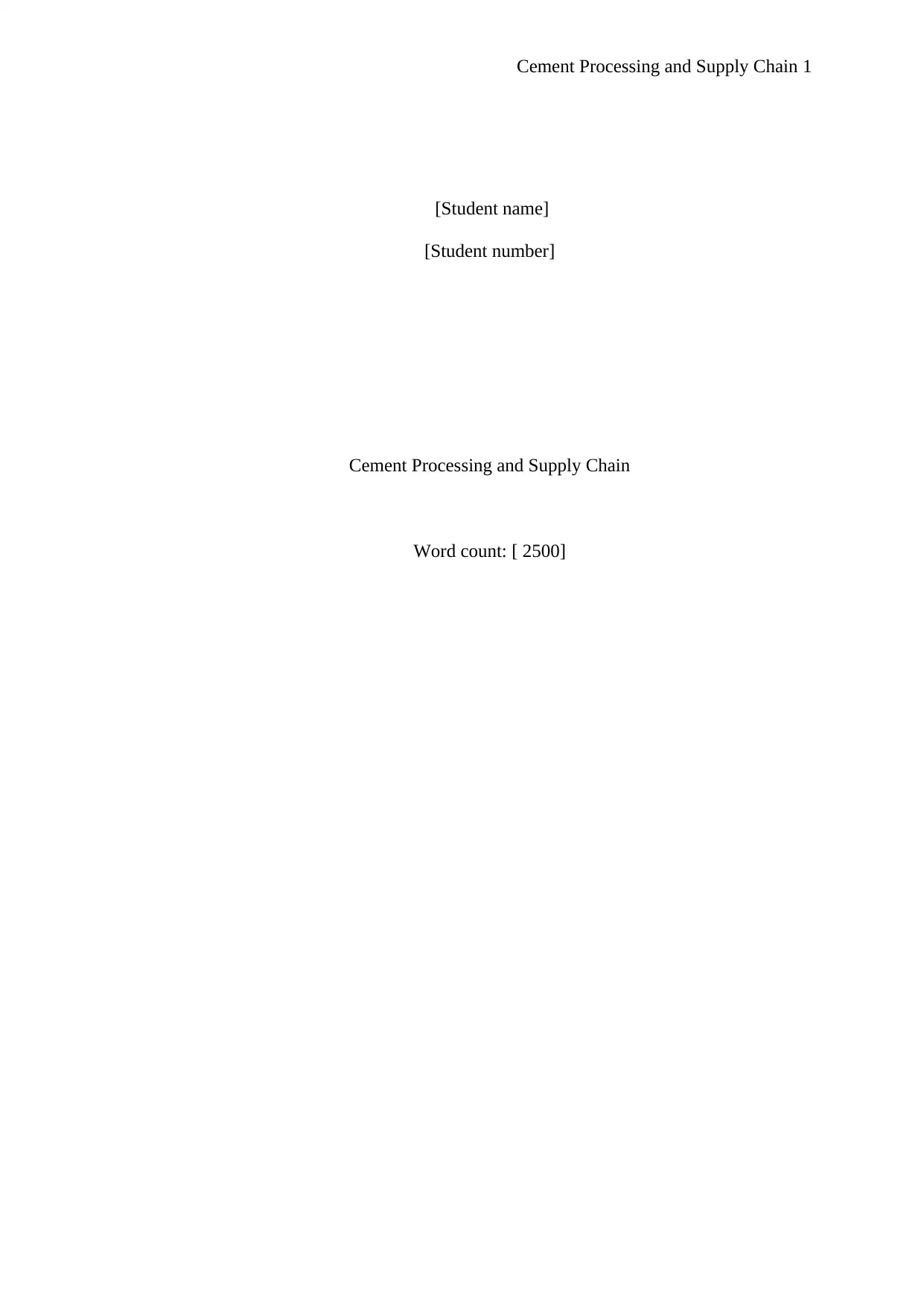
Cement Processing and Supply Chain 1
[Student name]
[Student number]
Cement Processing and Supply Chain
Word count: [ 2500]
[Student name]
[Student number]
Cement Processing and Supply Chain
Word count: [ 2500]
Paraphrase This Document
Need a fresh take? Get an instant paraphrase of this document with our AI Paraphraser
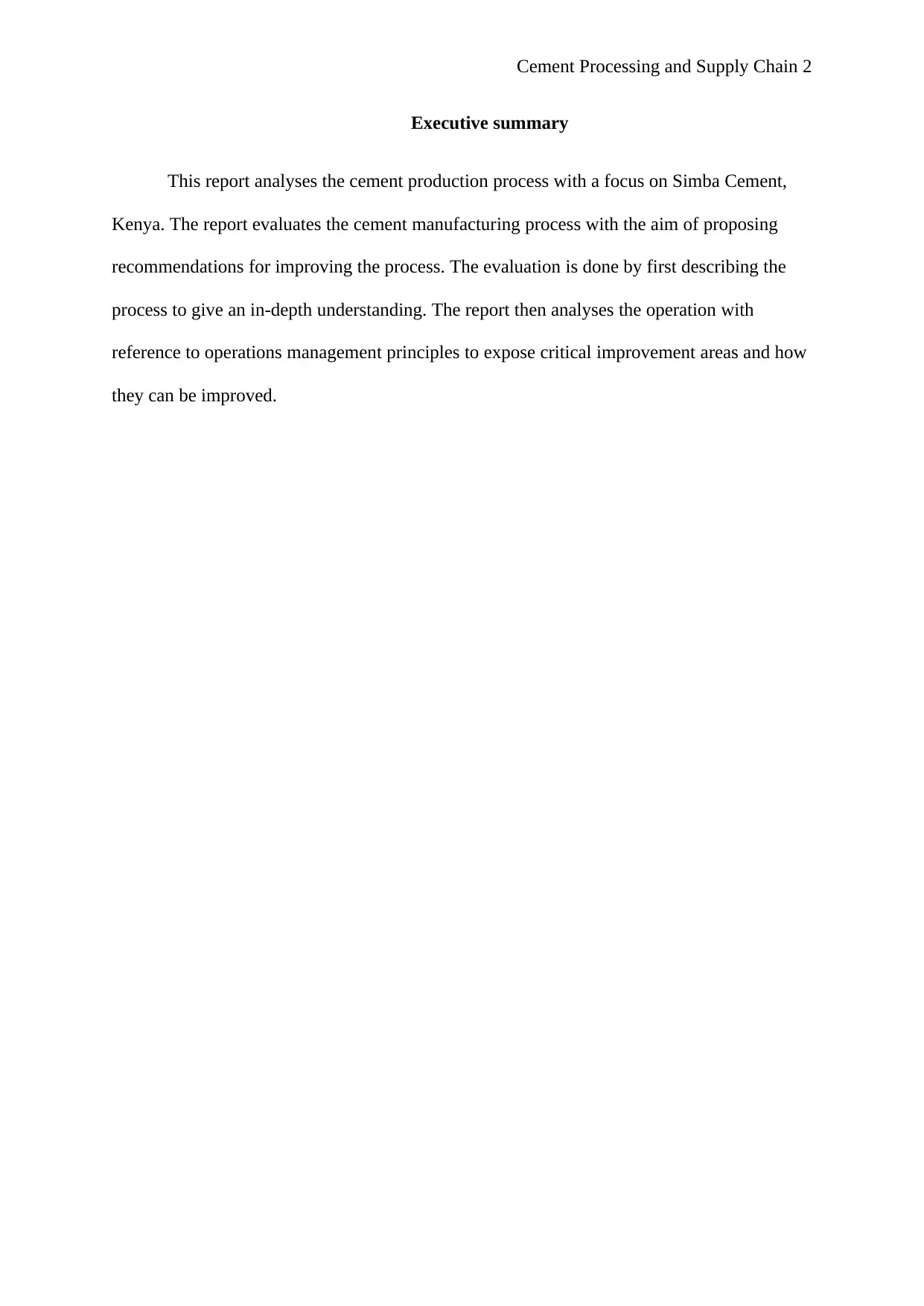
Cement Processing and Supply Chain 2
Executive summary
This report analyses the cement production process with a focus on Simba Cement,
Kenya. The report evaluates the cement manufacturing process with the aim of proposing
recommendations for improving the process. The evaluation is done by first describing the
process to give an in-depth understanding. The report then analyses the operation with
reference to operations management principles to expose critical improvement areas and how
they can be improved.
Executive summary
This report analyses the cement production process with a focus on Simba Cement,
Kenya. The report evaluates the cement manufacturing process with the aim of proposing
recommendations for improving the process. The evaluation is done by first describing the
process to give an in-depth understanding. The report then analyses the operation with
reference to operations management principles to expose critical improvement areas and how
they can be improved.
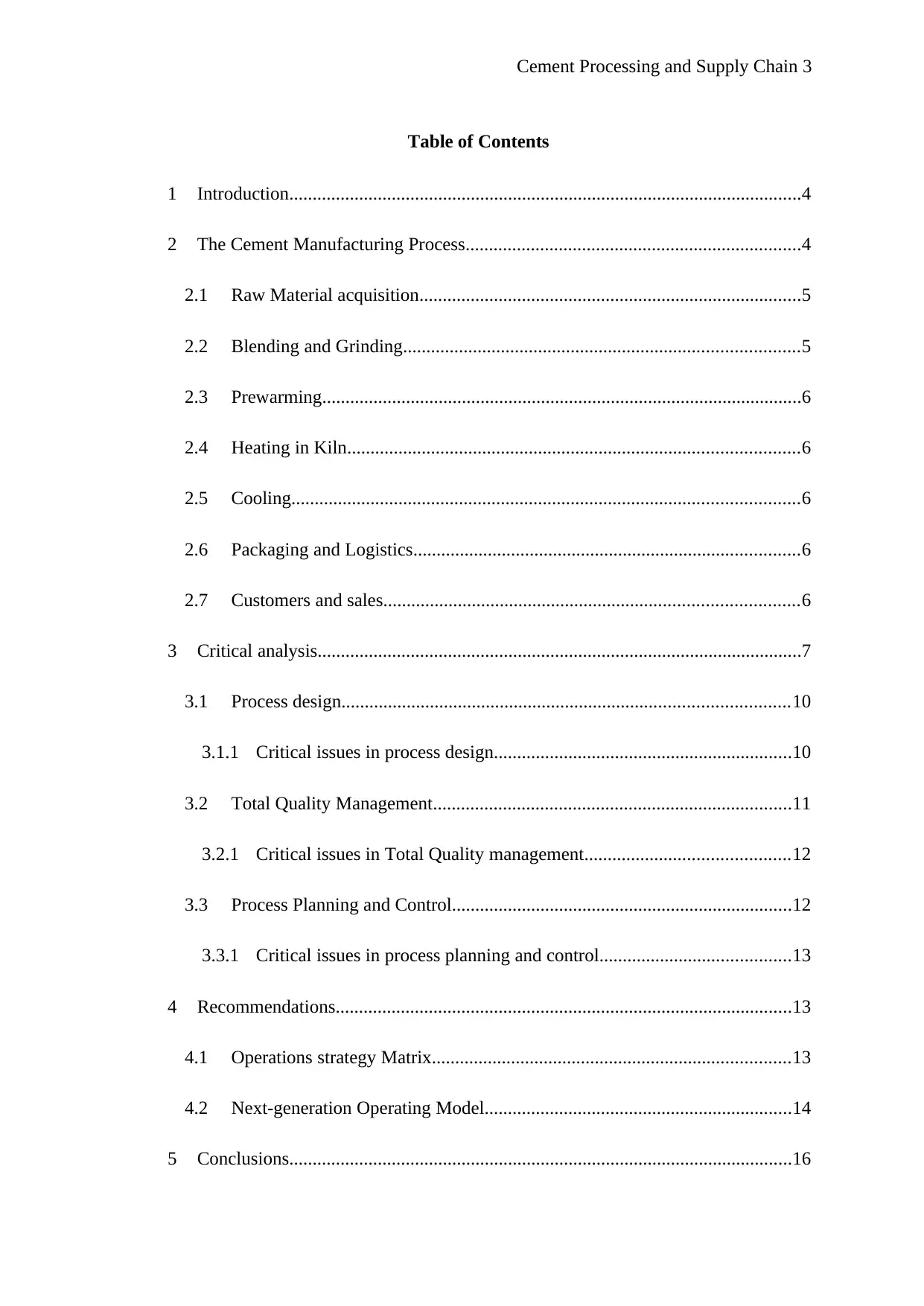
Cement Processing and Supply Chain 3
Table of Contents
1 Introduction..............................................................................................................4
2 The Cement Manufacturing Process........................................................................4
2.1 Raw Material acquisition..................................................................................5
2.2 Blending and Grinding.....................................................................................5
2.3 Prewarming.......................................................................................................6
2.4 Heating in Kiln.................................................................................................6
2.5 Cooling.............................................................................................................6
2.6 Packaging and Logistics...................................................................................6
2.7 Customers and sales.........................................................................................6
3 Critical analysis........................................................................................................7
3.1 Process design................................................................................................10
3.1.1 Critical issues in process design................................................................10
3.2 Total Quality Management.............................................................................11
3.2.1 Critical issues in Total Quality management............................................12
3.3 Process Planning and Control.........................................................................12
3.3.1 Critical issues in process planning and control.........................................13
4 Recommendations..................................................................................................13
4.1 Operations strategy Matrix.............................................................................13
4.2 Next-generation Operating Model..................................................................14
5 Conclusions............................................................................................................16
Table of Contents
1 Introduction..............................................................................................................4
2 The Cement Manufacturing Process........................................................................4
2.1 Raw Material acquisition..................................................................................5
2.2 Blending and Grinding.....................................................................................5
2.3 Prewarming.......................................................................................................6
2.4 Heating in Kiln.................................................................................................6
2.5 Cooling.............................................................................................................6
2.6 Packaging and Logistics...................................................................................6
2.7 Customers and sales.........................................................................................6
3 Critical analysis........................................................................................................7
3.1 Process design................................................................................................10
3.1.1 Critical issues in process design................................................................10
3.2 Total Quality Management.............................................................................11
3.2.1 Critical issues in Total Quality management............................................12
3.3 Process Planning and Control.........................................................................12
3.3.1 Critical issues in process planning and control.........................................13
4 Recommendations..................................................................................................13
4.1 Operations strategy Matrix.............................................................................13
4.2 Next-generation Operating Model..................................................................14
5 Conclusions............................................................................................................16
⊘ This is a preview!⊘
Do you want full access?
Subscribe today to unlock all pages.

Trusted by 1+ million students worldwide
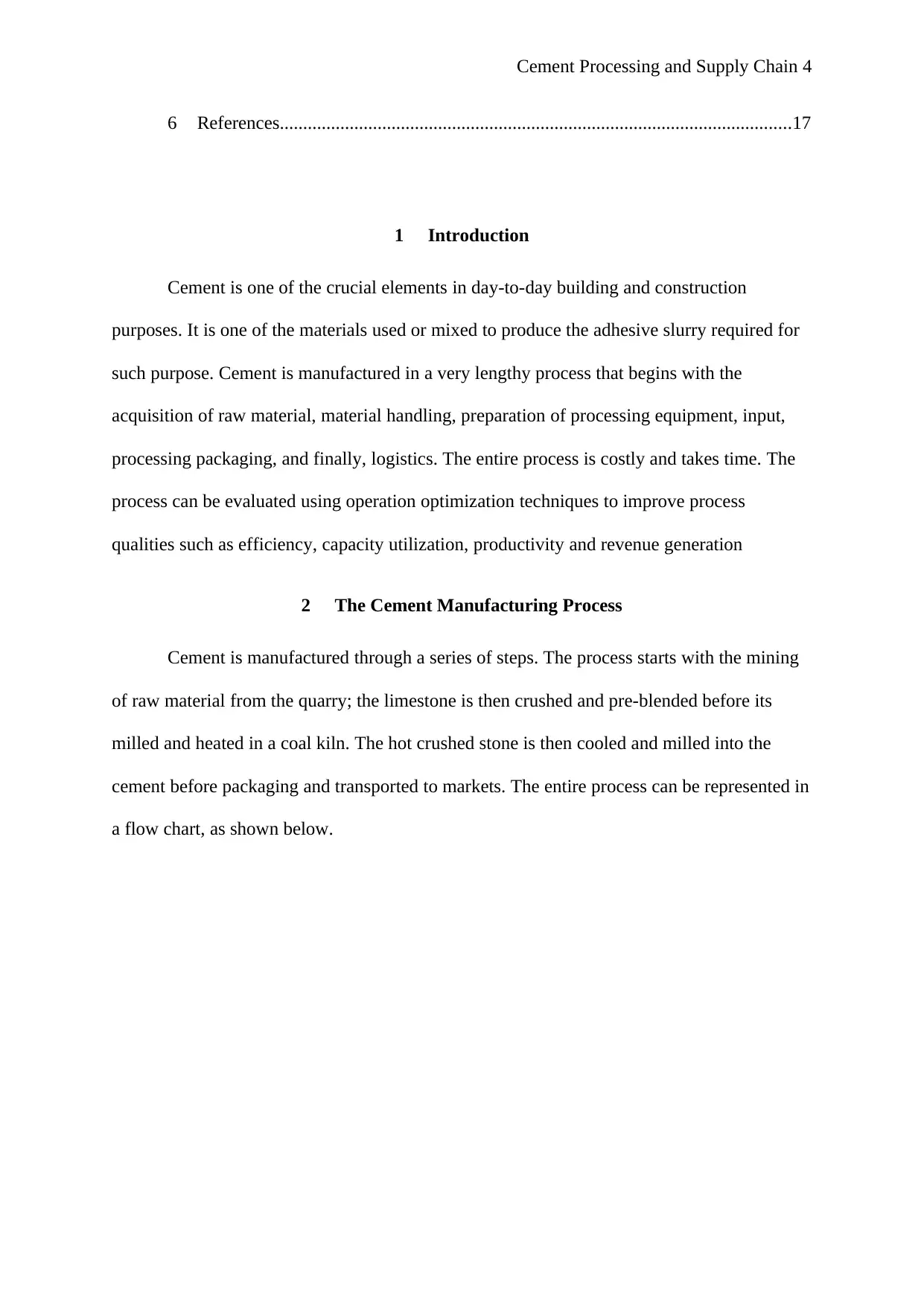
Cement Processing and Supply Chain 4
6 References..............................................................................................................17
1 Introduction
Cement is one of the crucial elements in day-to-day building and construction
purposes. It is one of the materials used or mixed to produce the adhesive slurry required for
such purpose. Cement is manufactured in a very lengthy process that begins with the
acquisition of raw material, material handling, preparation of processing equipment, input,
processing packaging, and finally, logistics. The entire process is costly and takes time. The
process can be evaluated using operation optimization techniques to improve process
qualities such as efficiency, capacity utilization, productivity and revenue generation
2 The Cement Manufacturing Process
Cement is manufactured through a series of steps. The process starts with the mining
of raw material from the quarry; the limestone is then crushed and pre-blended before its
milled and heated in a coal kiln. The hot crushed stone is then cooled and milled into the
cement before packaging and transported to markets. The entire process can be represented in
a flow chart, as shown below.
6 References..............................................................................................................17
1 Introduction
Cement is one of the crucial elements in day-to-day building and construction
purposes. It is one of the materials used or mixed to produce the adhesive slurry required for
such purpose. Cement is manufactured in a very lengthy process that begins with the
acquisition of raw material, material handling, preparation of processing equipment, input,
processing packaging, and finally, logistics. The entire process is costly and takes time. The
process can be evaluated using operation optimization techniques to improve process
qualities such as efficiency, capacity utilization, productivity and revenue generation
2 The Cement Manufacturing Process
Cement is manufactured through a series of steps. The process starts with the mining
of raw material from the quarry; the limestone is then crushed and pre-blended before its
milled and heated in a coal kiln. The hot crushed stone is then cooled and milled into the
cement before packaging and transported to markets. The entire process can be represented in
a flow chart, as shown below.
Paraphrase This Document
Need a fresh take? Get an instant paraphrase of this document with our AI Paraphraser
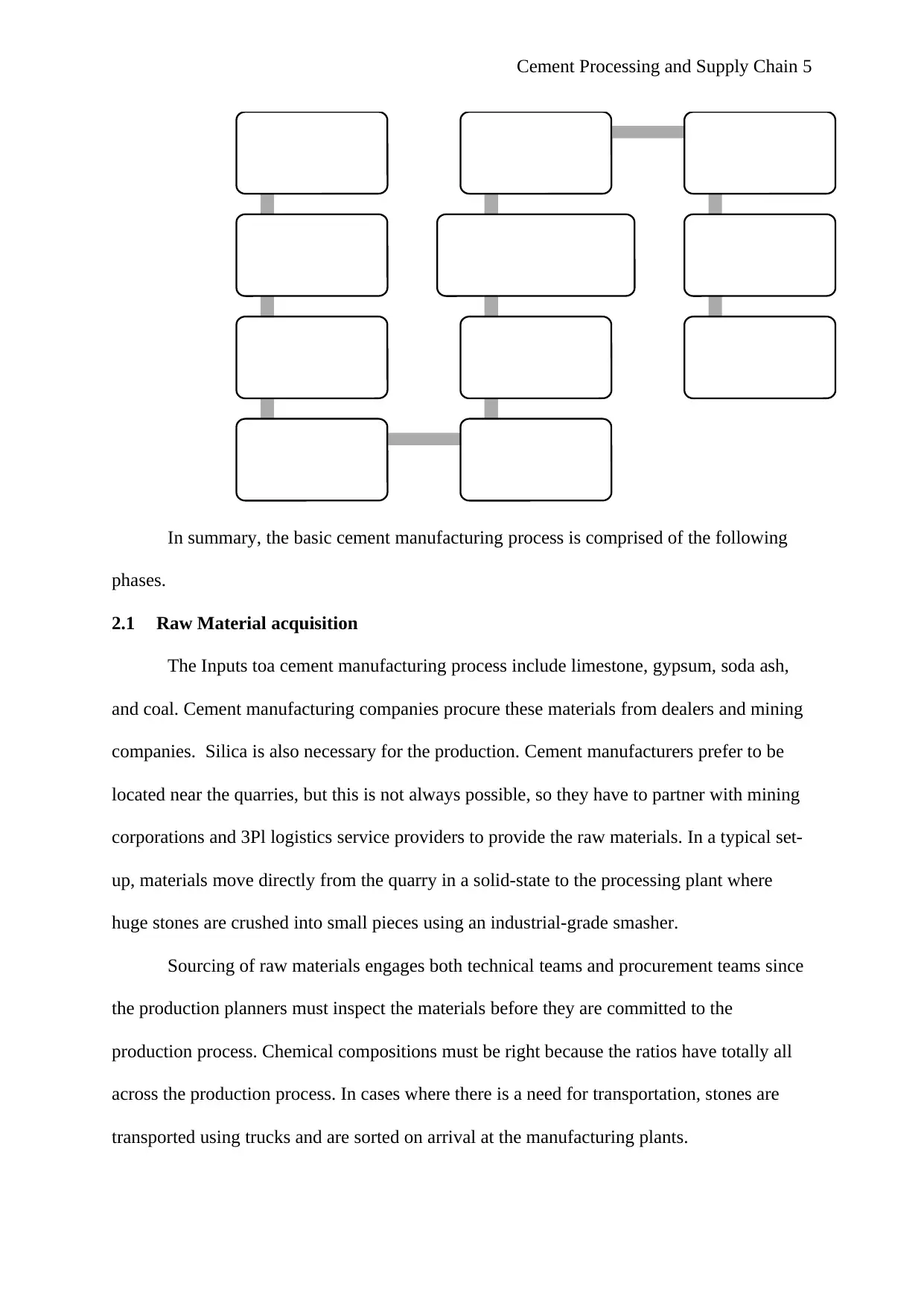
Cement Processing and Supply Chain 5
In summary, the basic cement manufacturing process is comprised of the following
phases.
2.1 Raw Material acquisition
The Inputs toa cement manufacturing process include limestone, gypsum, soda ash,
and coal. Cement manufacturing companies procure these materials from dealers and mining
companies. Silica is also necessary for the production. Cement manufacturers prefer to be
located near the quarries, but this is not always possible, so they have to partner with mining
corporations and 3Pl logistics service providers to provide the raw materials. In a typical set-
up, materials move directly from the quarry in a solid-state to the processing plant where
huge stones are crushed into small pieces using an industrial-grade smasher.
Sourcing of raw materials engages both technical teams and procurement teams since
the production planners must inspect the materials before they are committed to the
production process. Chemical compositions must be right because the ratios have totally all
across the production process. In cases where there is a need for transportation, stones are
transported using trucks and are sorted on arrival at the manufacturing plants.
Mining
Crushing
Blending&Recl
aiming
Raw Milling
Heating In Kiln
Heating With
Coal
Cooling
Cement Milling
Adding Gypsusm
Fly ash
Storage In Silos PAckaging
Logistics
Markets
In summary, the basic cement manufacturing process is comprised of the following
phases.
2.1 Raw Material acquisition
The Inputs toa cement manufacturing process include limestone, gypsum, soda ash,
and coal. Cement manufacturing companies procure these materials from dealers and mining
companies. Silica is also necessary for the production. Cement manufacturers prefer to be
located near the quarries, but this is not always possible, so they have to partner with mining
corporations and 3Pl logistics service providers to provide the raw materials. In a typical set-
up, materials move directly from the quarry in a solid-state to the processing plant where
huge stones are crushed into small pieces using an industrial-grade smasher.
Sourcing of raw materials engages both technical teams and procurement teams since
the production planners must inspect the materials before they are committed to the
production process. Chemical compositions must be right because the ratios have totally all
across the production process. In cases where there is a need for transportation, stones are
transported using trucks and are sorted on arrival at the manufacturing plants.
Mining
Crushing
Blending&Recl
aiming
Raw Milling
Heating In Kiln
Heating With
Coal
Cooling
Cement Milling
Adding Gypsusm
Fly ash
Storage In Silos PAckaging
Logistics
Markets
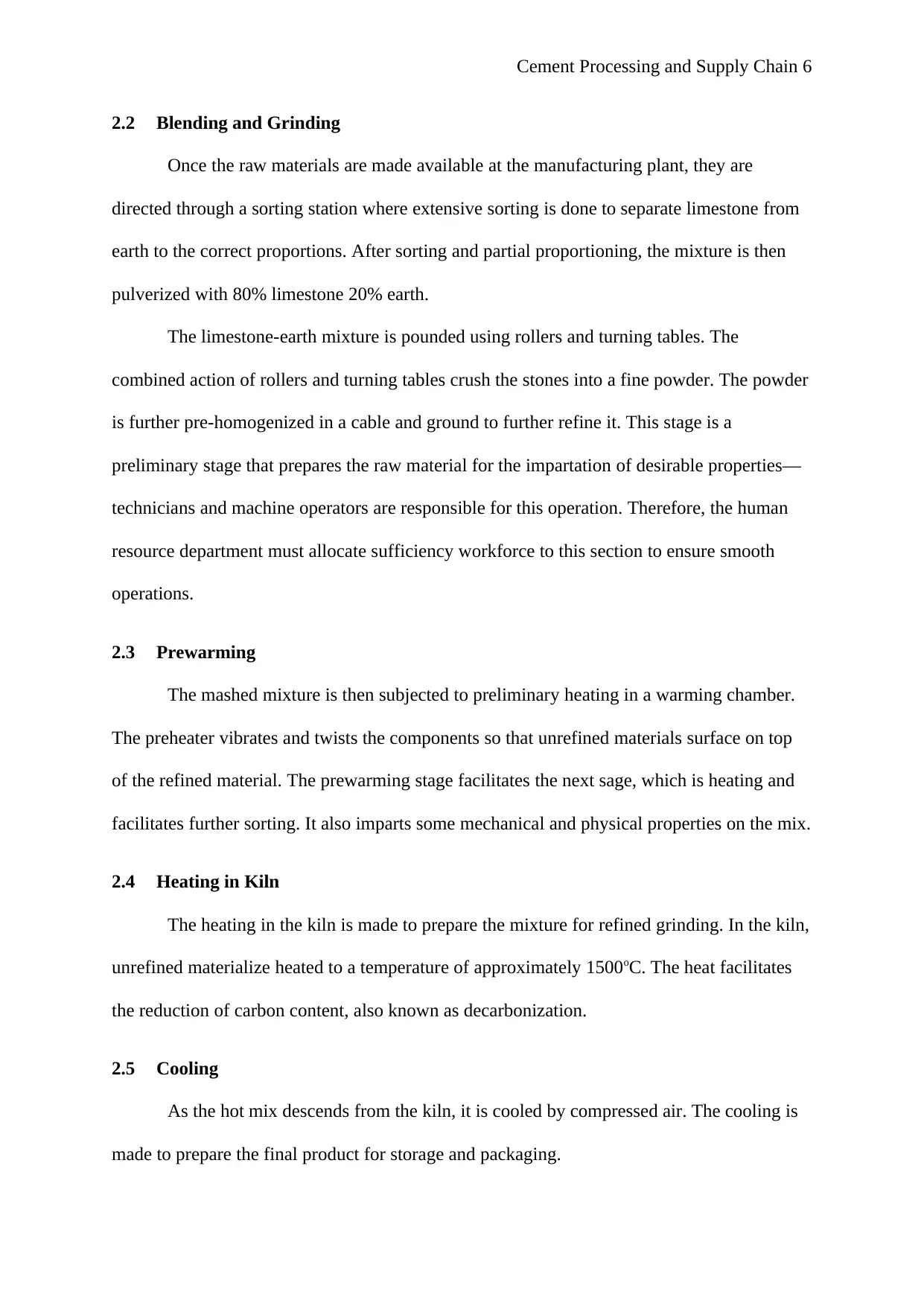
Cement Processing and Supply Chain 6
2.2 Blending and Grinding
Once the raw materials are made available at the manufacturing plant, they are
directed through a sorting station where extensive sorting is done to separate limestone from
earth to the correct proportions. After sorting and partial proportioning, the mixture is then
pulverized with 80% limestone 20% earth.
The limestone-earth mixture is pounded using rollers and turning tables. The
combined action of rollers and turning tables crush the stones into a fine powder. The powder
is further pre-homogenized in a cable and ground to further refine it. This stage is a
preliminary stage that prepares the raw material for the impartation of desirable properties—
technicians and machine operators are responsible for this operation. Therefore, the human
resource department must allocate sufficiency workforce to this section to ensure smooth
operations.
2.3 Prewarming
The mashed mixture is then subjected to preliminary heating in a warming chamber.
The preheater vibrates and twists the components so that unrefined materials surface on top
of the refined material. The prewarming stage facilitates the next sage, which is heating and
facilitates further sorting. It also imparts some mechanical and physical properties on the mix.
2.4 Heating in Kiln
The heating in the kiln is made to prepare the mixture for refined grinding. In the kiln,
unrefined materialize heated to a temperature of approximately 1500oC. The heat facilitates
the reduction of carbon content, also known as decarbonization.
2.5 Cooling
As the hot mix descends from the kiln, it is cooled by compressed air. The cooling is
made to prepare the final product for storage and packaging.
2.2 Blending and Grinding
Once the raw materials are made available at the manufacturing plant, they are
directed through a sorting station where extensive sorting is done to separate limestone from
earth to the correct proportions. After sorting and partial proportioning, the mixture is then
pulverized with 80% limestone 20% earth.
The limestone-earth mixture is pounded using rollers and turning tables. The
combined action of rollers and turning tables crush the stones into a fine powder. The powder
is further pre-homogenized in a cable and ground to further refine it. This stage is a
preliminary stage that prepares the raw material for the impartation of desirable properties—
technicians and machine operators are responsible for this operation. Therefore, the human
resource department must allocate sufficiency workforce to this section to ensure smooth
operations.
2.3 Prewarming
The mashed mixture is then subjected to preliminary heating in a warming chamber.
The preheater vibrates and twists the components so that unrefined materials surface on top
of the refined material. The prewarming stage facilitates the next sage, which is heating and
facilitates further sorting. It also imparts some mechanical and physical properties on the mix.
2.4 Heating in Kiln
The heating in the kiln is made to prepare the mixture for refined grinding. In the kiln,
unrefined materialize heated to a temperature of approximately 1500oC. The heat facilitates
the reduction of carbon content, also known as decarbonization.
2.5 Cooling
As the hot mix descends from the kiln, it is cooled by compressed air. The cooling is
made to prepare the final product for storage and packaging.
⊘ This is a preview!⊘
Do you want full access?
Subscribe today to unlock all pages.

Trusted by 1+ million students worldwide
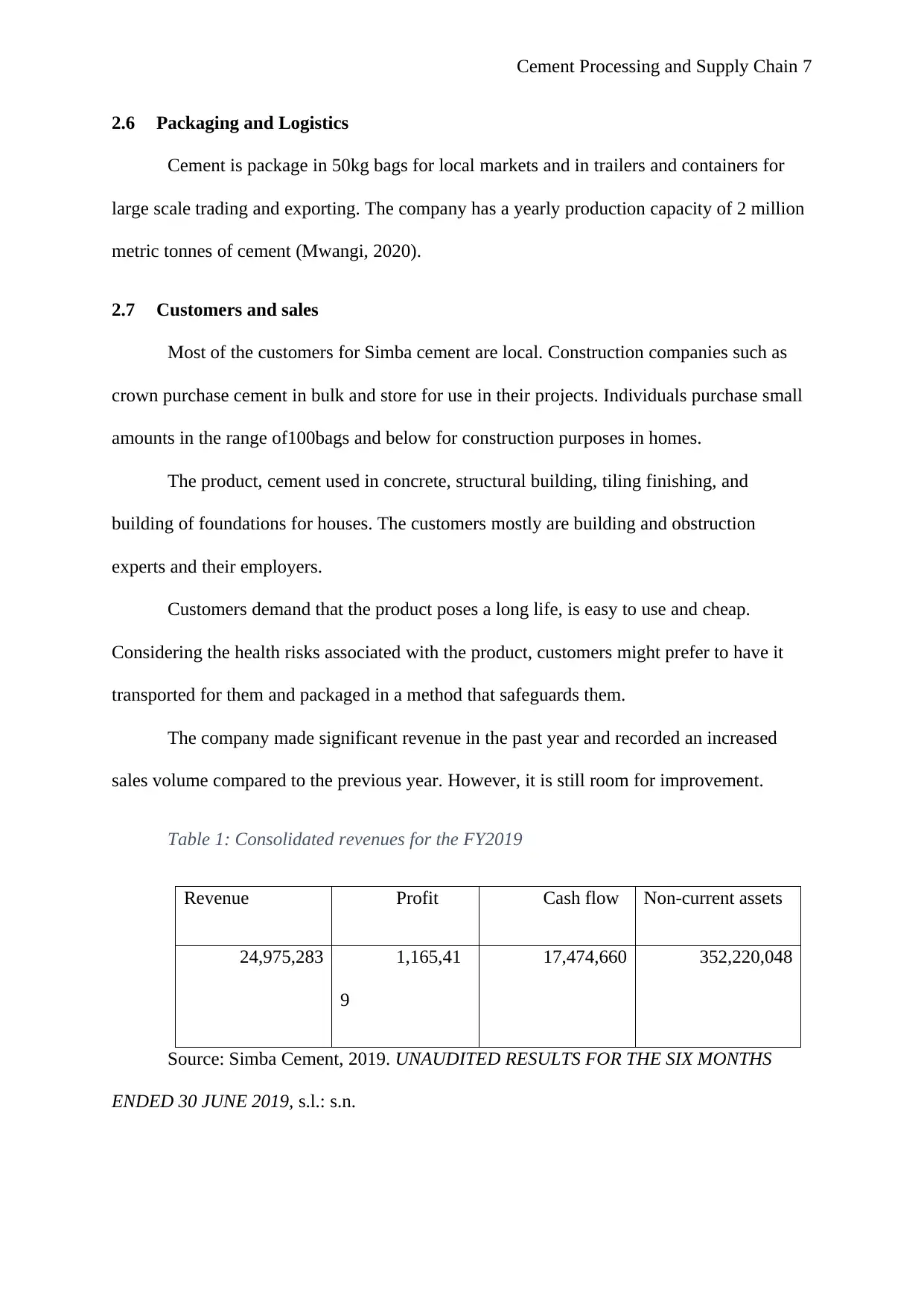
Cement Processing and Supply Chain 7
2.6 Packaging and Logistics
Cement is package in 50kg bags for local markets and in trailers and containers for
large scale trading and exporting. The company has a yearly production capacity of 2 million
metric tonnes of cement (Mwangi, 2020).
2.7 Customers and sales
Most of the customers for Simba cement are local. Construction companies such as
crown purchase cement in bulk and store for use in their projects. Individuals purchase small
amounts in the range of100bags and below for construction purposes in homes.
The product, cement used in concrete, structural building, tiling finishing, and
building of foundations for houses. The customers mostly are building and obstruction
experts and their employers.
Customers demand that the product poses a long life, is easy to use and cheap.
Considering the health risks associated with the product, customers might prefer to have it
transported for them and packaged in a method that safeguards them.
The company made significant revenue in the past year and recorded an increased
sales volume compared to the previous year. However, it is still room for improvement.
Table 1: Consolidated revenues for the FY2019
Revenue Profit Cash flow Non-current assets
24,975,283 1,165,41
9
17,474,660 352,220,048
Source: Simba Cement, 2019. UNAUDITED RESULTS FOR THE SIX MONTHS
ENDED 30 JUNE 2019, s.l.: s.n.
2.6 Packaging and Logistics
Cement is package in 50kg bags for local markets and in trailers and containers for
large scale trading and exporting. The company has a yearly production capacity of 2 million
metric tonnes of cement (Mwangi, 2020).
2.7 Customers and sales
Most of the customers for Simba cement are local. Construction companies such as
crown purchase cement in bulk and store for use in their projects. Individuals purchase small
amounts in the range of100bags and below for construction purposes in homes.
The product, cement used in concrete, structural building, tiling finishing, and
building of foundations for houses. The customers mostly are building and obstruction
experts and their employers.
Customers demand that the product poses a long life, is easy to use and cheap.
Considering the health risks associated with the product, customers might prefer to have it
transported for them and packaged in a method that safeguards them.
The company made significant revenue in the past year and recorded an increased
sales volume compared to the previous year. However, it is still room for improvement.
Table 1: Consolidated revenues for the FY2019
Revenue Profit Cash flow Non-current assets
24,975,283 1,165,41
9
17,474,660 352,220,048
Source: Simba Cement, 2019. UNAUDITED RESULTS FOR THE SIX MONTHS
ENDED 30 JUNE 2019, s.l.: s.n.
Paraphrase This Document
Need a fresh take? Get an instant paraphrase of this document with our AI Paraphraser
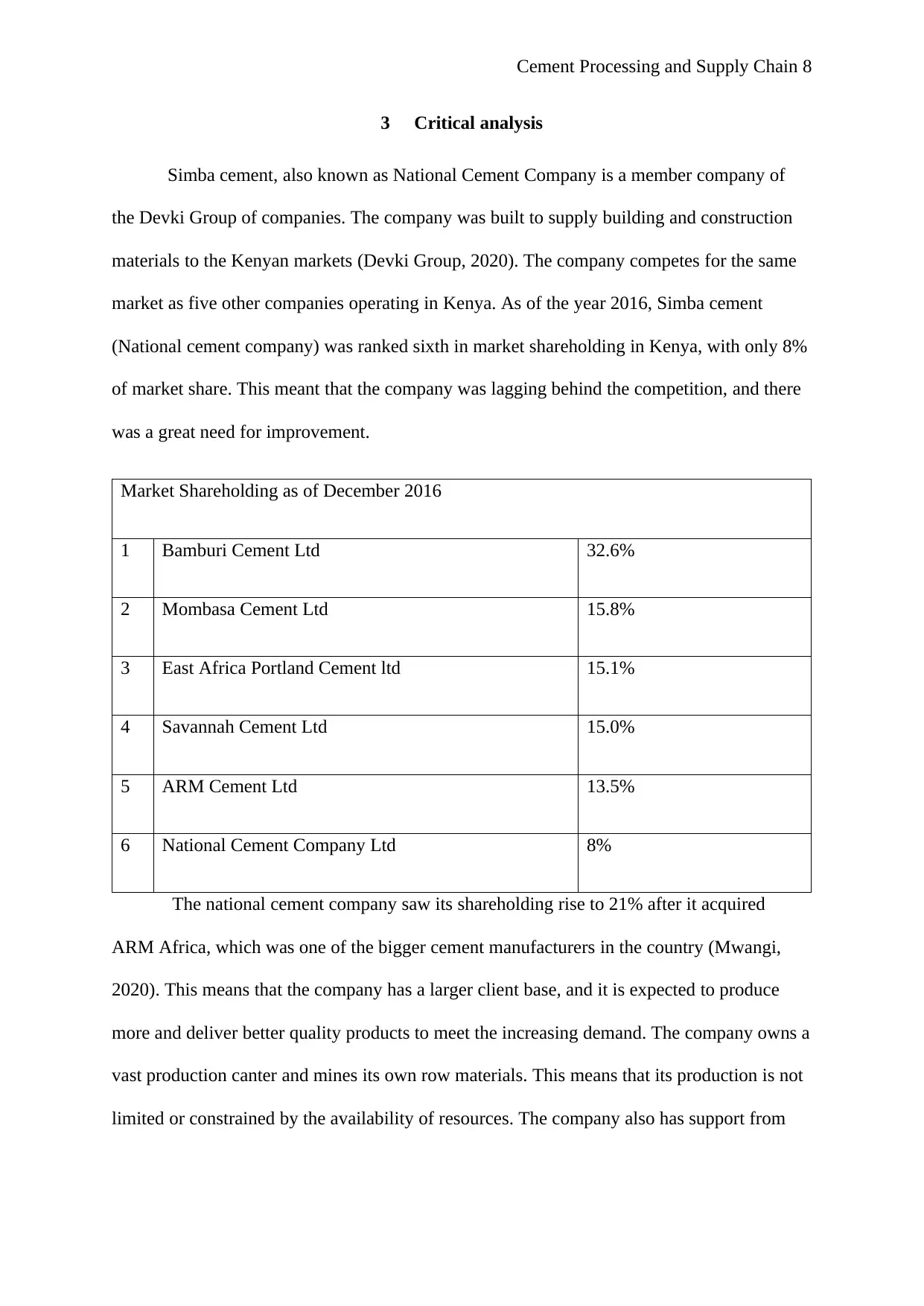
Cement Processing and Supply Chain 8
3 Critical analysis
Simba cement, also known as National Cement Company is a member company of
the Devki Group of companies. The company was built to supply building and construction
materials to the Kenyan markets (Devki Group, 2020). The company competes for the same
market as five other companies operating in Kenya. As of the year 2016, Simba cement
(National cement company) was ranked sixth in market shareholding in Kenya, with only 8%
of market share. This meant that the company was lagging behind the competition, and there
was a great need for improvement.
Market Shareholding as of December 2016
1 Bamburi Cement Ltd 32.6%
2 Mombasa Cement Ltd 15.8%
3 East Africa Portland Cement ltd 15.1%
4 Savannah Cement Ltd 15.0%
5 ARM Cement Ltd 13.5%
6 National Cement Company Ltd 8%
The national cement company saw its shareholding rise to 21% after it acquired
ARM Africa, which was one of the bigger cement manufacturers in the country (Mwangi,
2020). This means that the company has a larger client base, and it is expected to produce
more and deliver better quality products to meet the increasing demand. The company owns a
vast production canter and mines its own row materials. This means that its production is not
limited or constrained by the availability of resources. The company also has support from
3 Critical analysis
Simba cement, also known as National Cement Company is a member company of
the Devki Group of companies. The company was built to supply building and construction
materials to the Kenyan markets (Devki Group, 2020). The company competes for the same
market as five other companies operating in Kenya. As of the year 2016, Simba cement
(National cement company) was ranked sixth in market shareholding in Kenya, with only 8%
of market share. This meant that the company was lagging behind the competition, and there
was a great need for improvement.
Market Shareholding as of December 2016
1 Bamburi Cement Ltd 32.6%
2 Mombasa Cement Ltd 15.8%
3 East Africa Portland Cement ltd 15.1%
4 Savannah Cement Ltd 15.0%
5 ARM Cement Ltd 13.5%
6 National Cement Company Ltd 8%
The national cement company saw its shareholding rise to 21% after it acquired
ARM Africa, which was one of the bigger cement manufacturers in the country (Mwangi,
2020). This means that the company has a larger client base, and it is expected to produce
more and deliver better quality products to meet the increasing demand. The company owns a
vast production canter and mines its own row materials. This means that its production is not
limited or constrained by the availability of resources. The company also has support from
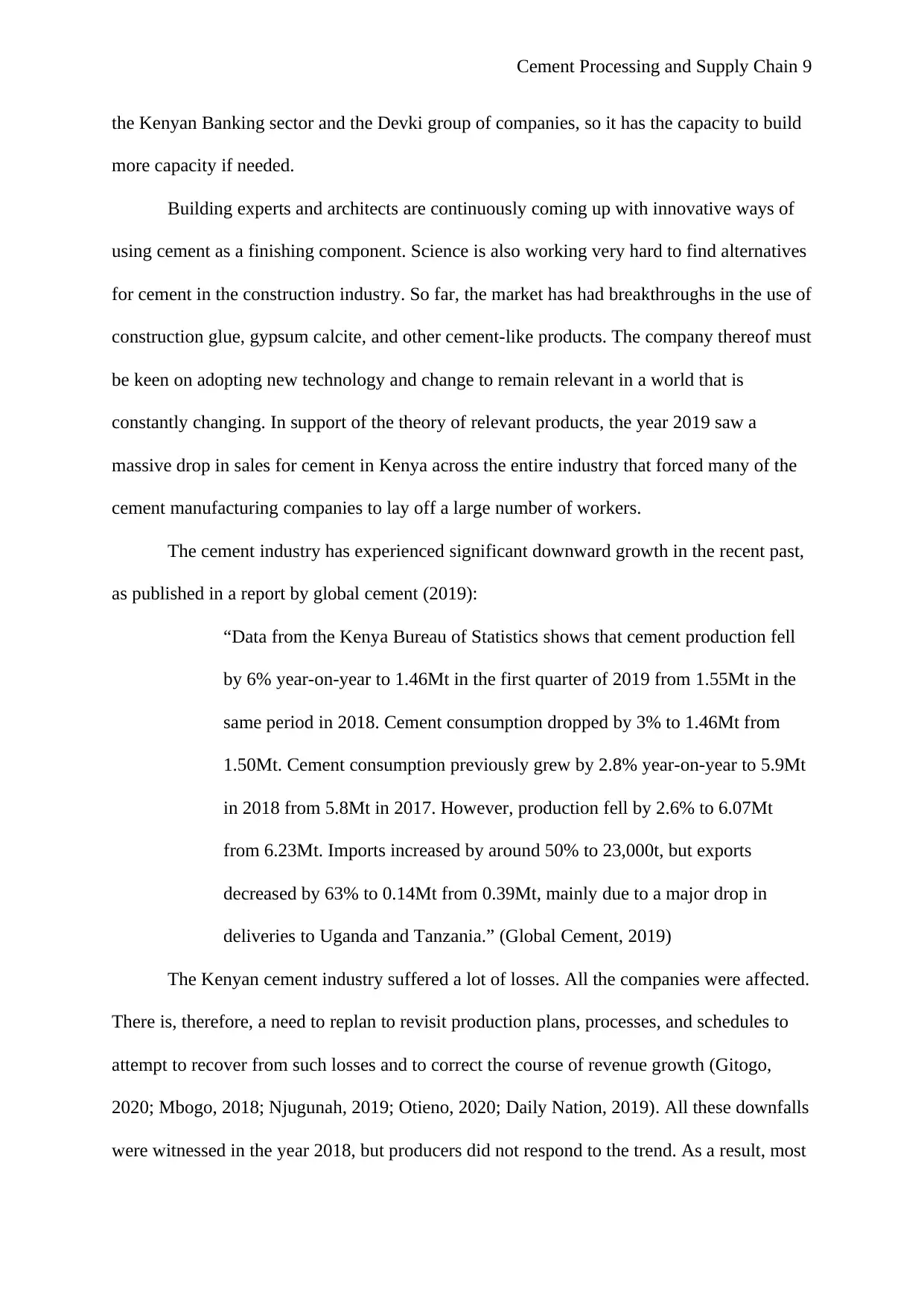
Cement Processing and Supply Chain 9
the Kenyan Banking sector and the Devki group of companies, so it has the capacity to build
more capacity if needed.
Building experts and architects are continuously coming up with innovative ways of
using cement as a finishing component. Science is also working very hard to find alternatives
for cement in the construction industry. So far, the market has had breakthroughs in the use of
construction glue, gypsum calcite, and other cement-like products. The company thereof must
be keen on adopting new technology and change to remain relevant in a world that is
constantly changing. In support of the theory of relevant products, the year 2019 saw a
massive drop in sales for cement in Kenya across the entire industry that forced many of the
cement manufacturing companies to lay off a large number of workers.
The cement industry has experienced significant downward growth in the recent past,
as published in a report by global cement (2019):
“Data from the Kenya Bureau of Statistics shows that cement production fell
by 6% year-on-year to 1.46Mt in the first quarter of 2019 from 1.55Mt in the
same period in 2018. Cement consumption dropped by 3% to 1.46Mt from
1.50Mt. Cement consumption previously grew by 2.8% year-on-year to 5.9Mt
in 2018 from 5.8Mt in 2017. However, production fell by 2.6% to 6.07Mt
from 6.23Mt. Imports increased by around 50% to 23,000t, but exports
decreased by 63% to 0.14Mt from 0.39Mt, mainly due to a major drop in
deliveries to Uganda and Tanzania.” (Global Cement, 2019)
The Kenyan cement industry suffered a lot of losses. All the companies were affected.
There is, therefore, a need to replan to revisit production plans, processes, and schedules to
attempt to recover from such losses and to correct the course of revenue growth (Gitogo,
2020; Mbogo, 2018; Njugunah, 2019; Otieno, 2020; Daily Nation, 2019). All these downfalls
were witnessed in the year 2018, but producers did not respond to the trend. As a result, most
the Kenyan Banking sector and the Devki group of companies, so it has the capacity to build
more capacity if needed.
Building experts and architects are continuously coming up with innovative ways of
using cement as a finishing component. Science is also working very hard to find alternatives
for cement in the construction industry. So far, the market has had breakthroughs in the use of
construction glue, gypsum calcite, and other cement-like products. The company thereof must
be keen on adopting new technology and change to remain relevant in a world that is
constantly changing. In support of the theory of relevant products, the year 2019 saw a
massive drop in sales for cement in Kenya across the entire industry that forced many of the
cement manufacturing companies to lay off a large number of workers.
The cement industry has experienced significant downward growth in the recent past,
as published in a report by global cement (2019):
“Data from the Kenya Bureau of Statistics shows that cement production fell
by 6% year-on-year to 1.46Mt in the first quarter of 2019 from 1.55Mt in the
same period in 2018. Cement consumption dropped by 3% to 1.46Mt from
1.50Mt. Cement consumption previously grew by 2.8% year-on-year to 5.9Mt
in 2018 from 5.8Mt in 2017. However, production fell by 2.6% to 6.07Mt
from 6.23Mt. Imports increased by around 50% to 23,000t, but exports
decreased by 63% to 0.14Mt from 0.39Mt, mainly due to a major drop in
deliveries to Uganda and Tanzania.” (Global Cement, 2019)
The Kenyan cement industry suffered a lot of losses. All the companies were affected.
There is, therefore, a need to replan to revisit production plans, processes, and schedules to
attempt to recover from such losses and to correct the course of revenue growth (Gitogo,
2020; Mbogo, 2018; Njugunah, 2019; Otieno, 2020; Daily Nation, 2019). All these downfalls
were witnessed in the year 2018, but producers did not respond to the trend. As a result, most
⊘ This is a preview!⊘
Do you want full access?
Subscribe today to unlock all pages.

Trusted by 1+ million students worldwide
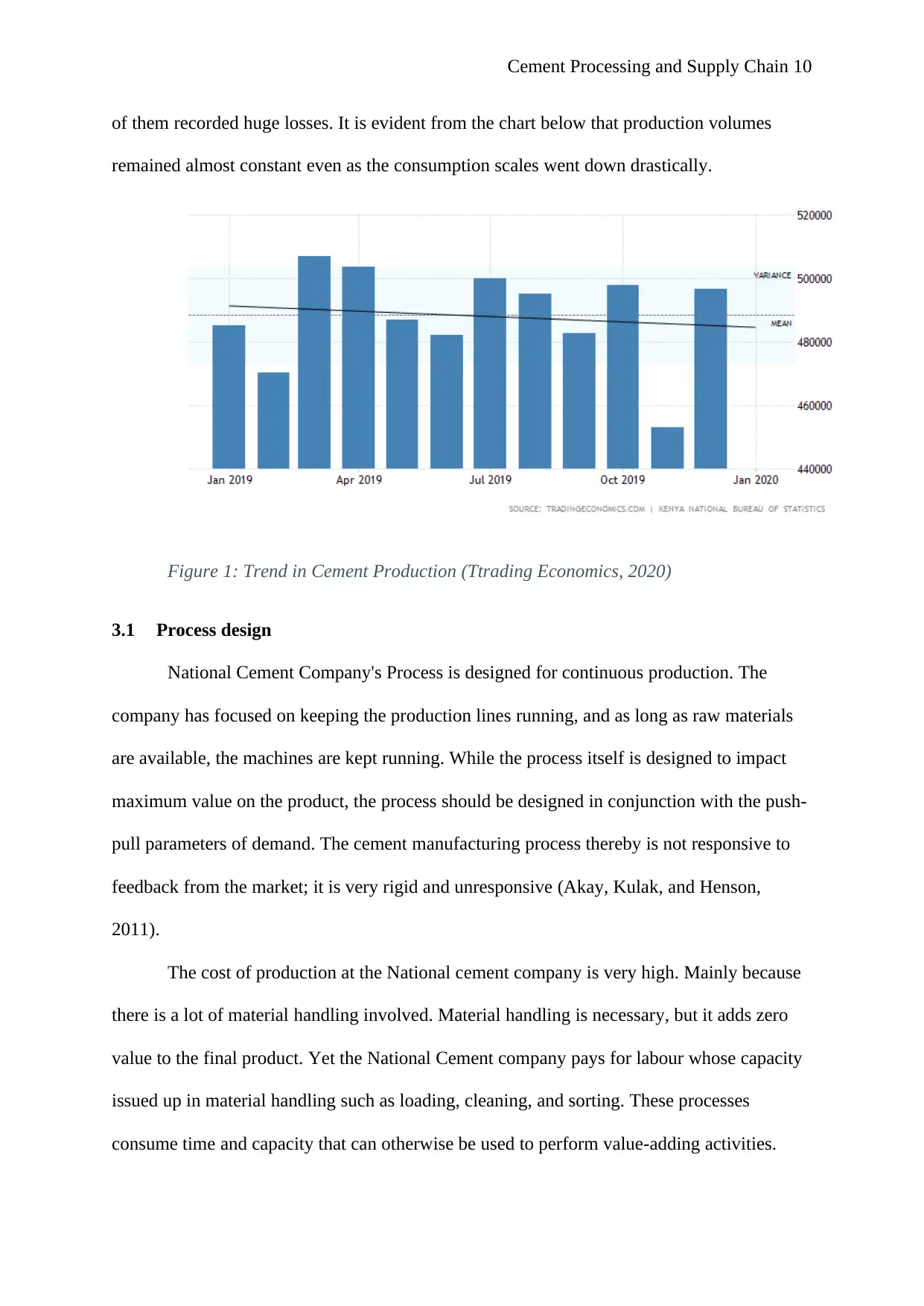
Cement Processing and Supply Chain 10
of them recorded huge losses. It is evident from the chart below that production volumes
remained almost constant even as the consumption scales went down drastically.
Figure 1: Trend in Cement Production (Ttrading Economics, 2020)
3.1 Process design
National Cement Company's Process is designed for continuous production. The
company has focused on keeping the production lines running, and as long as raw materials
are available, the machines are kept running. While the process itself is designed to impact
maximum value on the product, the process should be designed in conjunction with the push-
pull parameters of demand. The cement manufacturing process thereby is not responsive to
feedback from the market; it is very rigid and unresponsive (Akay, Kulak, and Henson,
2011).
The cost of production at the National cement company is very high. Mainly because
there is a lot of material handling involved. Material handling is necessary, but it adds zero
value to the final product. Yet the National Cement company pays for labour whose capacity
issued up in material handling such as loading, cleaning, and sorting. These processes
consume time and capacity that can otherwise be used to perform value-adding activities.
of them recorded huge losses. It is evident from the chart below that production volumes
remained almost constant even as the consumption scales went down drastically.
Figure 1: Trend in Cement Production (Ttrading Economics, 2020)
3.1 Process design
National Cement Company's Process is designed for continuous production. The
company has focused on keeping the production lines running, and as long as raw materials
are available, the machines are kept running. While the process itself is designed to impact
maximum value on the product, the process should be designed in conjunction with the push-
pull parameters of demand. The cement manufacturing process thereby is not responsive to
feedback from the market; it is very rigid and unresponsive (Akay, Kulak, and Henson,
2011).
The cost of production at the National cement company is very high. Mainly because
there is a lot of material handling involved. Material handling is necessary, but it adds zero
value to the final product. Yet the National Cement company pays for labour whose capacity
issued up in material handling such as loading, cleaning, and sorting. These processes
consume time and capacity that can otherwise be used to perform value-adding activities.
Paraphrase This Document
Need a fresh take? Get an instant paraphrase of this document with our AI Paraphraser
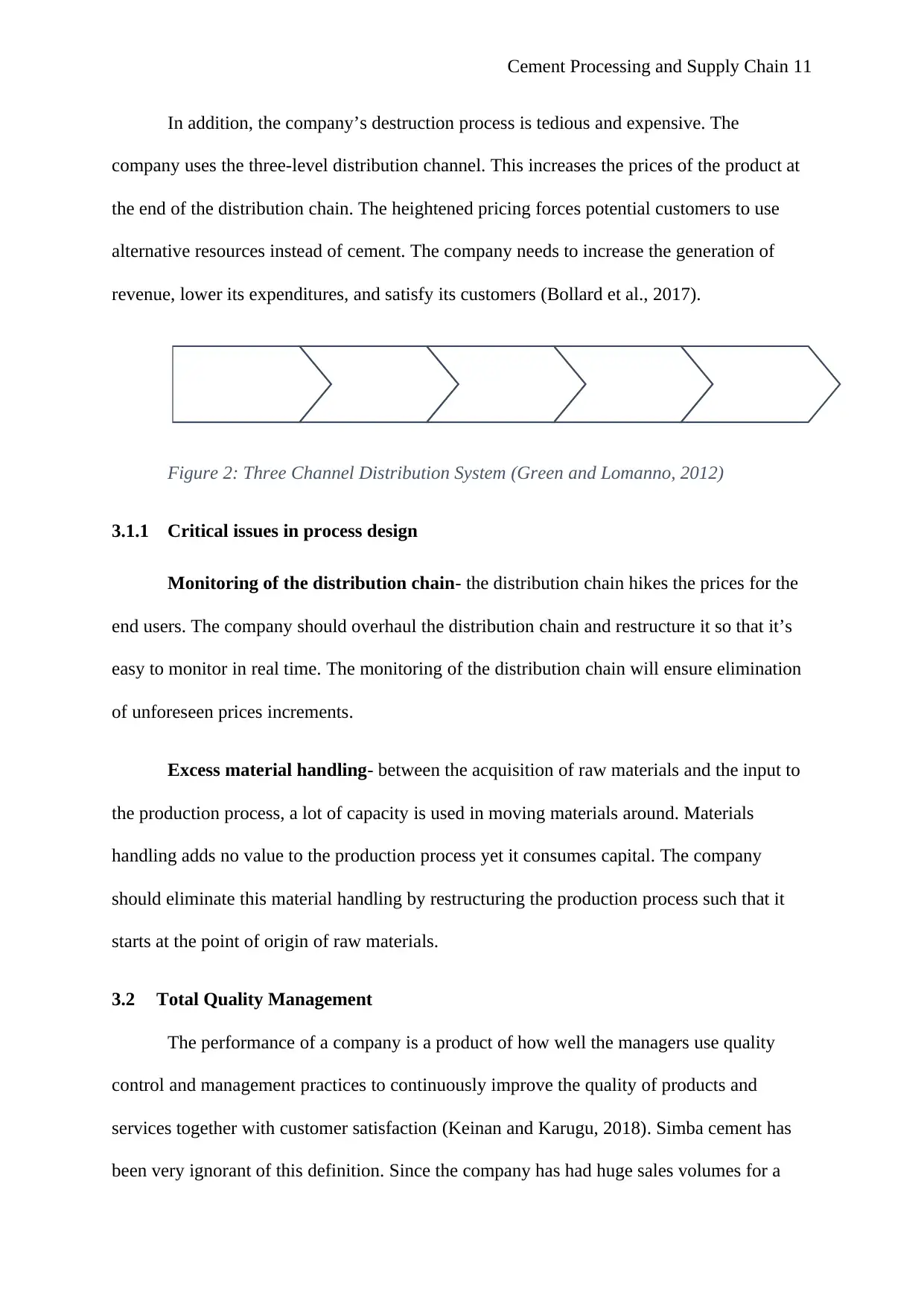
Cement Processing and Supply Chain 11
In addition, the company’s destruction process is tedious and expensive. The
company uses the three-level distribution channel. This increases the prices of the product at
the end of the distribution chain. The heightened pricing forces potential customers to use
alternative resources instead of cement. The company needs to increase the generation of
revenue, lower its expenditures, and satisfy its customers (Bollard et al., 2017).
Figure 2: Three Channel Distribution System (Green and Lomanno, 2012)
3.1.1 Critical issues in process design
Monitoring of the distribution chain- the distribution chain hikes the prices for the
end users. The company should overhaul the distribution chain and restructure it so that it’s
easy to monitor in real time. The monitoring of the distribution chain will ensure elimination
of unforeseen prices increments.
Excess material handling- between the acquisition of raw materials and the input to
the production process, a lot of capacity is used in moving materials around. Materials
handling adds no value to the production process yet it consumes capital. The company
should eliminate this material handling by restructuring the production process such that it
starts at the point of origin of raw materials.
3.2 Total Quality Management
The performance of a company is a product of how well the managers use quality
control and management practices to continuously improve the quality of products and
services together with customer satisfaction (Keinan and Karugu, 2018). Simba cement has
been very ignorant of this definition. Since the company has had huge sales volumes for a
Manufacturer Wholesaler Jobber Retailer Consumer
In addition, the company’s destruction process is tedious and expensive. The
company uses the three-level distribution channel. This increases the prices of the product at
the end of the distribution chain. The heightened pricing forces potential customers to use
alternative resources instead of cement. The company needs to increase the generation of
revenue, lower its expenditures, and satisfy its customers (Bollard et al., 2017).
Figure 2: Three Channel Distribution System (Green and Lomanno, 2012)
3.1.1 Critical issues in process design
Monitoring of the distribution chain- the distribution chain hikes the prices for the
end users. The company should overhaul the distribution chain and restructure it so that it’s
easy to monitor in real time. The monitoring of the distribution chain will ensure elimination
of unforeseen prices increments.
Excess material handling- between the acquisition of raw materials and the input to
the production process, a lot of capacity is used in moving materials around. Materials
handling adds no value to the production process yet it consumes capital. The company
should eliminate this material handling by restructuring the production process such that it
starts at the point of origin of raw materials.
3.2 Total Quality Management
The performance of a company is a product of how well the managers use quality
control and management practices to continuously improve the quality of products and
services together with customer satisfaction (Keinan and Karugu, 2018). Simba cement has
been very ignorant of this definition. Since the company has had huge sales volumes for a
Manufacturer Wholesaler Jobber Retailer Consumer
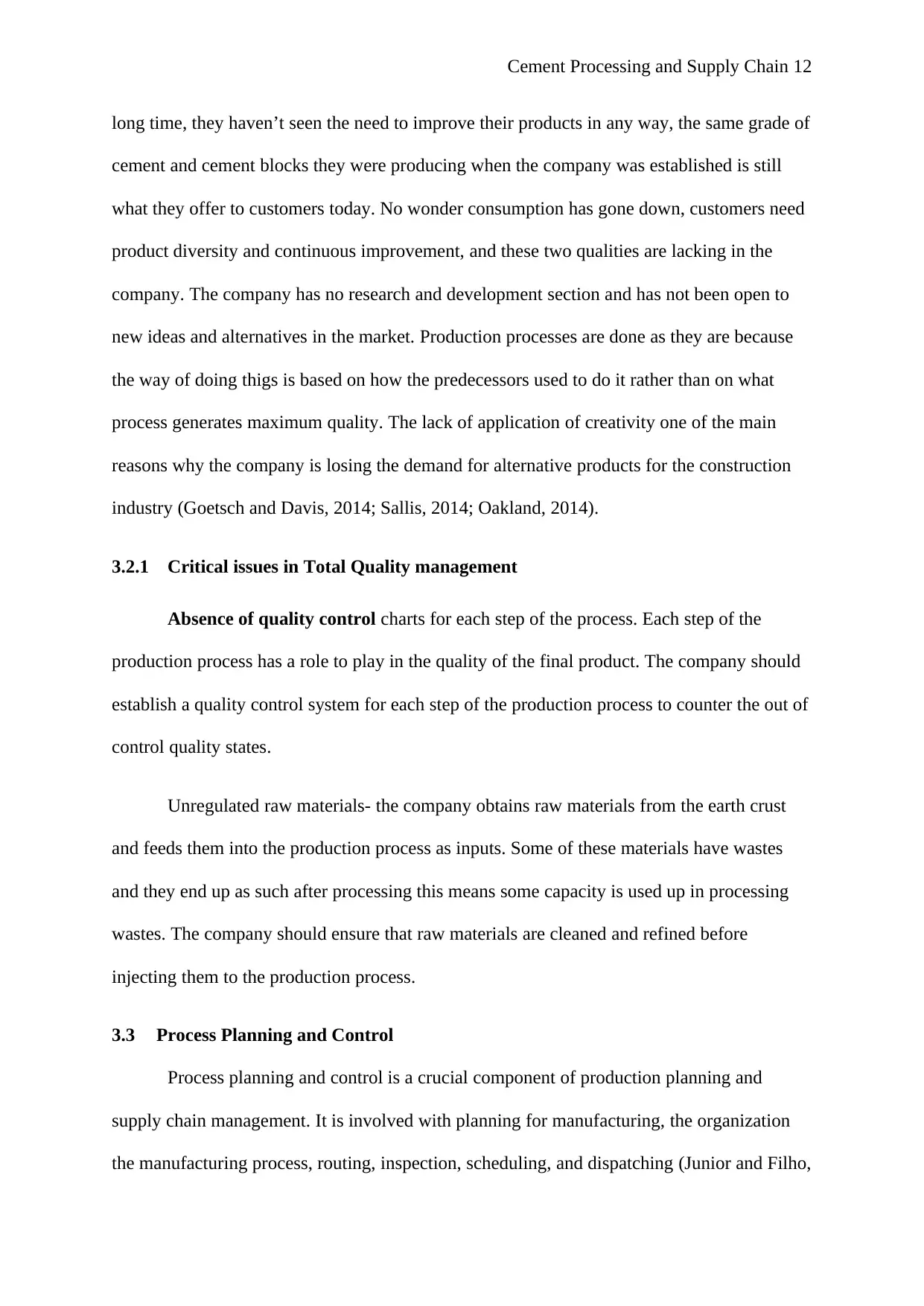
Cement Processing and Supply Chain 12
long time, they haven’t seen the need to improve their products in any way, the same grade of
cement and cement blocks they were producing when the company was established is still
what they offer to customers today. No wonder consumption has gone down, customers need
product diversity and continuous improvement, and these two qualities are lacking in the
company. The company has no research and development section and has not been open to
new ideas and alternatives in the market. Production processes are done as they are because
the way of doing thigs is based on how the predecessors used to do it rather than on what
process generates maximum quality. The lack of application of creativity one of the main
reasons why the company is losing the demand for alternative products for the construction
industry (Goetsch and Davis, 2014; Sallis, 2014; Oakland, 2014).
3.2.1 Critical issues in Total Quality management
Absence of quality control charts for each step of the process. Each step of the
production process has a role to play in the quality of the final product. The company should
establish a quality control system for each step of the production process to counter the out of
control quality states.
Unregulated raw materials- the company obtains raw materials from the earth crust
and feeds them into the production process as inputs. Some of these materials have wastes
and they end up as such after processing this means some capacity is used up in processing
wastes. The company should ensure that raw materials are cleaned and refined before
injecting them to the production process.
3.3 Process Planning and Control
Process planning and control is a crucial component of production planning and
supply chain management. It is involved with planning for manufacturing, the organization
the manufacturing process, routing, inspection, scheduling, and dispatching (Junior and Filho,
long time, they haven’t seen the need to improve their products in any way, the same grade of
cement and cement blocks they were producing when the company was established is still
what they offer to customers today. No wonder consumption has gone down, customers need
product diversity and continuous improvement, and these two qualities are lacking in the
company. The company has no research and development section and has not been open to
new ideas and alternatives in the market. Production processes are done as they are because
the way of doing thigs is based on how the predecessors used to do it rather than on what
process generates maximum quality. The lack of application of creativity one of the main
reasons why the company is losing the demand for alternative products for the construction
industry (Goetsch and Davis, 2014; Sallis, 2014; Oakland, 2014).
3.2.1 Critical issues in Total Quality management
Absence of quality control charts for each step of the process. Each step of the
production process has a role to play in the quality of the final product. The company should
establish a quality control system for each step of the production process to counter the out of
control quality states.
Unregulated raw materials- the company obtains raw materials from the earth crust
and feeds them into the production process as inputs. Some of these materials have wastes
and they end up as such after processing this means some capacity is used up in processing
wastes. The company should ensure that raw materials are cleaned and refined before
injecting them to the production process.
3.3 Process Planning and Control
Process planning and control is a crucial component of production planning and
supply chain management. It is involved with planning for manufacturing, the organization
the manufacturing process, routing, inspection, scheduling, and dispatching (Junior and Filho,
⊘ This is a preview!⊘
Do you want full access?
Subscribe today to unlock all pages.

Trusted by 1+ million students worldwide
1 out of 20
Your All-in-One AI-Powered Toolkit for Academic Success.
+13062052269
info@desklib.com
Available 24*7 on WhatsApp / Email
![[object Object]](/_next/static/media/star-bottom.7253800d.svg)
Unlock your academic potential
Copyright © 2020–2025 A2Z Services. All Rights Reserved. Developed and managed by ZUCOL.

